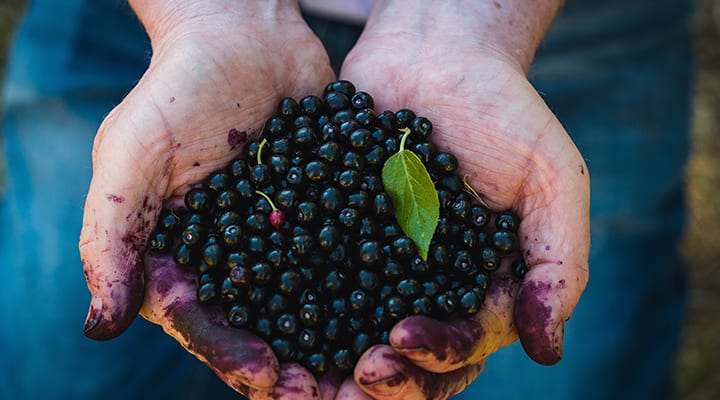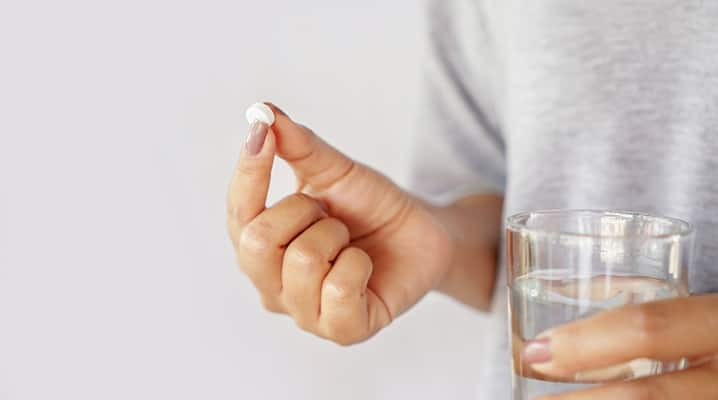
Top Maqui Berry Benefits For Eye Health
Published: October 2021 | Updated: November 2021
If you’re reading this on a computer screen, odds are that you’ve sat back and rubbed your eyes at least once before. Eye fatigue happens to the best of us—and that discomfort can get even worse if you’re one of millions who wear contacts, glasses, or have even had corrective surgery. You most likely know about eye drops for dry eyes, but did you know there’s a fruit extract that can help? Let’s take a look at maqui berry!
What is maqui berry used for?

Maqui berries come from Chile in South America. The Latin name is Aristotelia chilensis. There is a slight chance you’ve heard of them by another name: Chilean wineberry. No matter what it’s called, this superfood (well, it’s technically a super-fruit) is packed with anthocyanidins called delphinidins, plus a powerful antioxidant called ellagic acid.
It’s these beneficial compounds that scientists think are responsible for maqui’s value to ocular health and eye comfort. In pre-clinical models, orally administered maqui berry extract helped encourage tear production—without eye drops.

How does maqui berry work?
Researchers in Japan decided to evaluate two of the major anthocyanidins in maqui berry extract, to determine how well they can protect the delicate photoreceptor cells in the back of your eye. To do so, they exposed those same types of cells to visible light. Light can cause oxidative stress, which can damage the cells in your eye. The researchers found that these maqui berry compounds helped protect photoreceptors in the eye from oxidative stress-related damage induced by visible light.
So we know that maqui berry extract helps with oxidative stress and eye health inside your eye. But what’s that got to do with the eye surface? Eye discomfort and dry eyes is a very common experience. One of the reasons for it is that your eye (for whatever reason) doesn’t make enough lacrimal fluid—what you and I know as “tears.”
This is important because research suggests that maqui berry encourages increased tear production.
What are tears, anyway?
Tears might feel like water, but they’re much more complex than that: tears consist of a clear fluid that is released between your eye and its protective eyelid.
Your lacrimal gland releases lacrimal fluid (tears) that keep your eye moisturized and comfortable.
“Fix” dry eyes—without the drops

It’s important to note that maqui berry extract doesn’t make you cry like say, cutting an onion does. Instead, the compounds in maqui berry promote healthy levels of lacrimal fluid, which in turn makes it easier for your body to keep your eye well-lubricated and comfortable.
There’s another angle here: it’s theorized that certain kinds of oxidative stress can destabilize the thin tear film that covers your eyes at all times. This suggests that maqui’s potent antioxidant abilities may play a role in its effectiveness at relieving dry eye discomfort.
That effectiveness isn’t an urban legend, either: in a pilot clinical trial, 13 healthy volunteers with moderately dry eyes took 60 mg of a maqui berry extract. Compared to the placebo group, the people taking the maqui berry extract had significantly improved tear fluid volume and relief from dry-eye.
Why do onions make you cry?
While it might seem unrelated to maqui berry, there’s a chemical reason that onions make us cry…and it has to do with those same tear-producing glands that maqui berry comforts. Here’s how it works:
- When you cut an onion, it releases an unstable enzyme called lachrymatory-factor synthase is released into the air.
- That same synthase enzyme converts its own onion amino acids into sulfenic acid, which is unstable, so it quickly becomes syn-propanethial-S-oxide and is released into the kitchen.
- When this aerosol-onion-oxide-acid (note: not a technical term) touches our eyeballs, it stimulates the lachrymal glands that create tears. Voila! Now you’re crying. Let’s get back to maqui.

Does maqui berry help with eye fatigue?
Dry eyes, tired eyes, itchy eyes: anyone who’s suffered from one knows that the other two are very closely related. Maqui berry can also help relieve eye fatigue. In a clinical trial of 74 participants, 60 mg of maqui berry extract daily for 4 weeks encouraged healthy tear production as well as offered relief for tired, uncomfortable eyes.
When is the best time to consume maqui berry extract?

Bioavailability research has found that it takes about one to two hours for the compounds in maqui berry extract to reach maximum concentrations in your bloodstream.
Which maqui berry extract should I choose?
We know that it’s the delphinidins that give maqui berry extract its ability to promote eye health, relieve general eye fatigue, and encourage healthy eye lubrication and tear production from within. So look for a maqui berry extract that’s concentrated to give you the most of these antioxidants.
And you’re going to want one that delivers the same amount, every time: a process that is called standardization. In conclusion, maqui berry extract has antioxidant benefits, which help protect the delicate cells of your eye from oxidative stress.
References:
- Hitoe, S et al. "MaquiBright™ standardized maqui berry extract significantly increases tear fluid production and ameliorates dry eye-related symptoms in a clinical pilot trial." Panminerva Med., September 2014, https://pubmed.ncbi.nlm.nih.gov/25208615/
- Kojima, Takashi et al. “advances in the diagnosis and treatment of dry eye.” Prog Retin Eye Res., January 2020, https://pubmed.ncbi.nlm.nih.gov/32004729/
- Schön. Christiane et al. “Bioavailability Study of Maqui Berry Extract in healthy Subjects.” Nutrients, November 2018, https://pubmed.ncbi.nlm.nih.gov/30423989/
- "Advances in the diagnosis and treatment of dry eye." Prog Retin Eye Res. 2020 Jan 29:100842. doi: 10.1016/j.preteyeres.2020.100842. Epub ahead of print. PMID: 32004729.
- "Bioavailability Study of Maqui Berry Extract in Healthy Subjects." Nutrients. 2018 Nov 9;10(11):1720. doi: 10.3390/nu10111720. PMID: 30423989; PMCID: PMC6267473.
- "Delphinidin 3,5-O-diglucoside, a constituent of the maqui berry (Aristotelia chilensis) anthocyanin, restores tear secretion in a rat dry eye model." Journal of functional foods, Volume 10, September 2014, Pages 346-354.
- "Effects of MaquiBright® on improving eye dryness and fatigue in humans: A randomized, double-blind, placebo-controlled trial." Journal of Traditional and Complementary Medicine, Volume 9, Issue 3, 2019, Pages 172-178.
- "Maqui berry (Aristotelia chilensis) and the constituent delphinidin glycoside inhibit photoreceptor cell death induced by visible light." Food Chem. 2013 Aug 15;139(1-4):129-37. doi: 10.1016/j.foodchem.2013.01.036. Epub 2013 Jan 29
- "Why does chopping an onion make you cry?" Library of Congress, November 2019, https://www.loc.gov/everyday-mysteries/food-and-nutrition/item/why-does-chopping-an-onion-make-you-cry/
Like what you read?
Please subscribe to get email updates on this blog.



